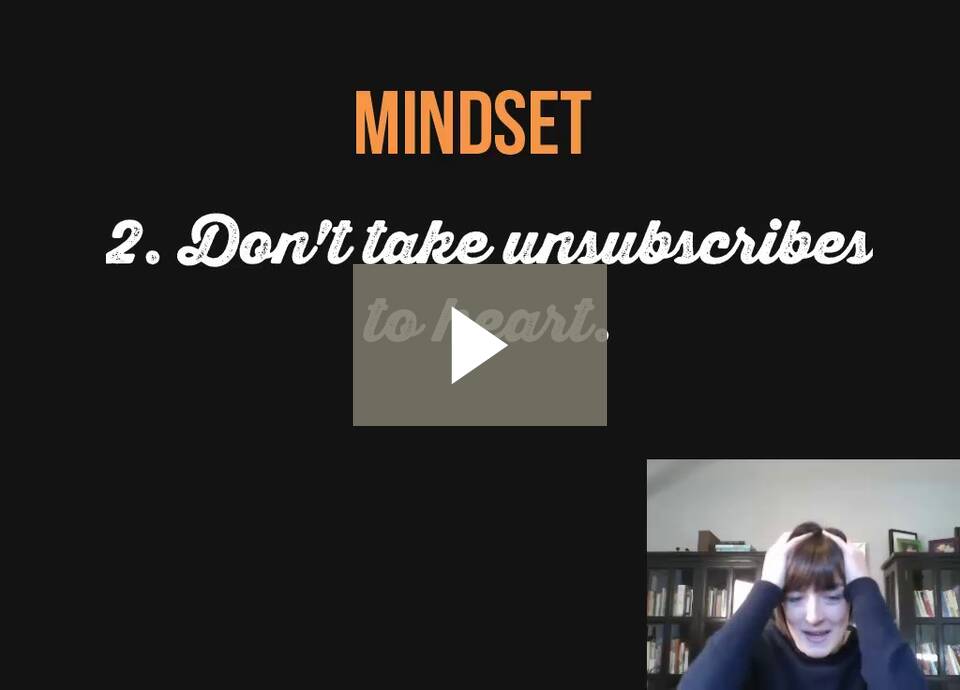Your company doesn’t have these 3 marketing positions? It’s time to change that!
Do you want to create successful marketing campaigns?
The digital environment has given rise to so many digital tools, platforms and strategies that one marketer in your company cannot do everything that is necessary to get results. There’s only so much one person can do!
That’s why the marketer position has branched out into new marketing positions in recent years. It takes a team of specialists with valuable insights to reach customers.
3 Marketing positions you need to have in your company: Email Designer, Chief Listening Officer and Demand Generation Manager.
1. Email Designer
Email is the first digital communication tool and has been used by people and businesses since the early 1970s.
But don’t make the mistake of assuming that since it’s almost fifty years old, email marketing is obsolete. Far from it!
People still want to hear from their favourite brands and that’s what email is: a direct line of communication between brands and customers.
Understanding the benefits of permission marketing could yield businesses an ROI as high as 4000%. For every $1 spent, email marketing brings in $40. If (and that’s a big IF) you use email correctly. That’s where the email designer comes in.

What is an email designer?
An email designer is a designer who specializes in designing emails for brands and businesses with the purpose of helping them meet their business targets.
The email designer is required to have coding skills, user experience design knowledge and an eye for beautiful imagery.
What does an email designer do?
The email designer’s job is to create a branded email template from zero or optimize third-party email templates with the goal of bringing in results: sales, brand awareness, in-store foot-traffic, leads, website traffic, event subscriptions etc.
The email designer works closely with the email marketer who provides them with the content and makes sure the result is on-brand.
Designing for email is about getting to the point and making the most of the brief chance you have with your subscribers. You only get one shot, so it’s worth employing as many tricks in the book as possible to make sure your message gets through. The underlying principles are all about respecting your readers by giving them something valuable in return for their time which is, after all, the reason they signed up to hear from you in the first place.
Nicole Merlin, Email designer and developer
2. Chief Listening Officer
It used to be that your customers listened to what you had to say on TV ads, outdoor banners and newspaper advertorials.
In this digital age, they are still listening to your messages but they are also talking about your brand, your products and your culture. Your customers are talking about you on social media, personal blogs and forums.
Learn more: 7 ways you can grow your business with social media listening tools
Are you listening to what they’re saying?
If you are not, you are missing opportunities for business growth, customer engagement and brand development.
There are many social listening tools that marketers can use, but the scope of this activity has increased so much in recent years that it generated demand for a standalone position: the Chief Listening Officer.

What is a Chief Listening Officer?
A Chief Listening Officer is a social media specialist who takes an overall approach to social.
The position is a step above social media manager and it is fairly new to the digital community.
What does the Chief Listening Officer do?
The Chief Listening Officer monitors the conversations which involve the brand or product.
The specialist listens with the purpose of getting a better understanding of what customers like or dislike about the brand or product and the overall sentiment around subjects relevant to the brand.
How are customers feeling about the brand: mostly positive, mostly negative or neutral?
What are their opinions?
What are they complaining about?
According to Brandwatch, 96% of the people that discuss brands online do not follow those brands’ owned profiles so monitoring the conversations around your brand is not an easy task.
The job of the Chief Listening Officer doesn’t stop at listening. He or she is expected to create strategies to influence and change the negative opinions into positive opinions or maintain the positive outlook that customers have on the brand.
Through social listening, the Chief Listening Officer gains valuable insights which they can transform into new product ideas, tips for product development and overall business growth.
With people being more willing to share opinions and ideas across social media, this job plays a big role in forward-thinking to stay ahead of the competition and keeping customers happy with your company.
Nicole Martin, owner of NR Digital Consulting and host of Talk Digital To Me Podcast
3. Demand Generation Manager
Demand generation refers to any activity that drives awareness and interest in your product or service with the ultimate goal to create a predictable pipeline that will grow your business.
Demand generation strategy includes creating demand for sales but is not limited by it.
Demand generation is about being at the right place in the right moment providing the right content to your customers. The content you share must be a perfect fit for your ideal customers’ needs.

What is a Demand Generation Manager?
A demand generation manager is a revenue-centric marketer with seasoned skills in inbound and outbound marketing.
What does the Demand Generation Manager do?
The demand generation manager develops, maintains and executes demand generation plans aligned with business goals.
They have a deep understanding of the buyer’s journey, ensuring that content reaches the right part of the sales funnel at the right time. They also collaborate with sales and marketing to build programs that support sales enablement.
The Demand Generation Manager helps your brand reach new markets, promote new product features and build consumer buzz.
Has your company established positions for Email Designer, Chief Listening Officer or Demand Generation Manager?
Share your answer in the comments!
Join the Conversation
We’d love to hear what you have to say.
Get in touch with us on Facebook Group and Twitter.
How To Write An Email That Actually Sells
When writing a business email the line between too little and too much may be very small, therefore is important to pay attention to some of the advices that the specialists offered during the years into how to write a successful email.
Being yourself in emails can bring you more long-term response than any other email tip, tactic or “technique” combined. Let your unique personality shine through in every word. Showing your partners the real you, will take you far. The business people are fed up of receiving robotic- mechanical email, full of the same key phrases that actually don’t say a thing. Introduce yourself, and your company, right away. Existing customers will greet you like an old friend, while potential shoppers won’t be forced to wonder if you are a shady scam artist.
Target your message to the right audience. Never forget what you are selling and to whom you are selling it. Remember that even the best crafted pitch is worthless if it’s delivered to someone who doesn’t want it.
Get to the point. According to Jupiter Communications research, only 15 percent of web users read all email messages in their entirety. More than half (51.2 percent) read the first few sentences and then decide whether or not to continue. Forcing your customer to wade through paragraphs of superfluous information is the quickest route to the delete key and to the death of a sale.
Be clear. Make sure that the information is presented in a clear matter. Use paragraphs, bold words, to highlight the most important part of the content and make sure it stands out and is not forgotten. Moreover, avoid the temptation to be too sophisticated in your design. Many systems still won’t support fancy formatting. Plus, most of it gets lost on the trip through the network anyway. Keep it easy on the eye.

Be an editor. Your customer needs to know he is buying from the best. Proofread. Break up run-on sentences. Use simple language. Catchy phrases don’t make up for sloppy punctuation and typos. And if you can’t write, hire someone who can.
Try a joke. Nothing works better than a good sense of humor, use at the right time and with the right amount of spice. Not an easy to do task at all, but one that proved to be quite efficient in time.
Tell stories. Stories are a great way to sell in emails, no matter the brand of the product or the service you are trying to pitch. If you succeeded in making the other side drawn into your story, then for sure you have a winning email. The reason is quite simple: people like to be emerged easily into the content, to be charmed, not to have the impression even from the beginning that you want to sell them something or the fact that this is your plan all along. Let the person reading the email be entertained, carried through the layers of the email and the information you are providing him. It will be much easy to be processed and understood.
And, in many cases, it’s the most persuasive way to get someone to do what you want. Whether it’s persuading someone to buy your product or persuading a child to be careful of talking to strangers — stories inspire and motivate people to take action.
Personalize it. Make sure you know to whom you are writing and address it accordingly, by name and position. Few things are more annoying that receiving a “bulk” email, addressed wrongly. Knowing a little about the person you are writing to and making sure you are saying it gets you a long way on the selling process.
The guys at hubspot.com give you even more ideas here.
How to have the best brand storytelling on Instagram
As storytelling is the latest trend in communication, all the agencies and companies trying to bring the concept to life in their campaigns and social media presence, Instagram is one of the latest powerful social media tools to try and capitalize on this trend.
According to Social Media Week, since Instagram launched a couple of years ago, over 300 million people have used this platform as a visual place to share their lives. With more than 20 billion images shared on the app to date–this app has become a creative space & community for people to share their story in innovative ways using photography and short videos.
It’s no wonder the stories on Instagram are catching up people’s attention and likeness as so many of them spending so much time on their mobile devices. What it does now for its users is allowing them to share their stories to the world in a quick and easy fashion. It has become a simple, yet powerful tool that has allowed people and brands to develop their own voice visually.
How can a brand take advantage of this trend and make himself even more noticeable on Instagram? Just take a pick here at our short pieces of advice:
- Identifying your niche & developing your own unique voice.
The way you position yourself is always the key. The more different, unique, special your brand is, the better. Make sure that your stories are always capturing that essence of the brand and special approach. By giving your audience something they know they can expect from you, it will be easier to grow a stronger and more dedicated community around your work.
- Utilizing your captions to add more depth to your photos.
Captions may become a vital part of your storytelling process, if you know how to put accent on them and use the right hashtags and words. The story behind the story is always important and should be relevant. Putting your own spin on the story, emphasizing on a certain aspect that makes your brand YOURS is helping bring the story where it should. Your story ultimately, makes a huge difference.
- Choosing and using different angles
The same places or the same ideas, presented in your brand’s way, are creating the differentiation that you are looking for. Instead of shooting something from the same angle as everyone else, try looking for new spots to take the same photo. Maybe you want to get closer to the ground for a different angle, pose a person in a different place, or shoot a photo through the branches of a tree to provide a more natural frame. There are always ways to put a new spin on the same place, and try to make sure you try a bunch of different angles.
- Highlight your brand’s versatility
People want the brands to be playful, to interact, engage and entertain them. They get bored really easy and you must make sure you always bring something fresh to the table. Don’t be afraid to try, to mix and match, to always have in handy a special new app or filter that is trendy. Make it count while is still fresh and not used by a lot of other brands present on Instagram. Your followers will be looking for powerful, original, content. Find ways to expand your current niche creatively to develop a strong brand voice.
- Using video and gifs
Always be present. Be fast and up-to-date. A video speaks more than a picture. A gif makes one laugh and entertains. In other words, powerful tools for your story.
- Making sure you have user-generated content
Getting your followers involved is extremely important for a TODAY brand. Get your audience to do some of the heavy lifting for you by creating a user-generated hashtag for your brand tribe. Then you can post the content of your biggest fans directly on your Instagram account.
- Showing your happy employees
There’s a global war for talent today and the best brands are showing off the fresh faces on their team and all the fun they are having at work. Showcasing yourself at work or your company’s employees in action is great for putting a human face on your brand, which makes what you share on Instagram more interesting to your followers.
- Introducing them behind-the-scenes
Each one of us loves to feel special and shown that they are important. Make sure your brand does that for its followers. You can start by taking them inside the stories of your company, showing them some never-seen before images, actions, activities, etc. Take them where nobody has been before!

